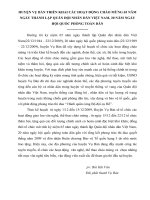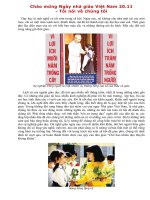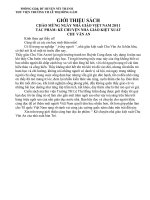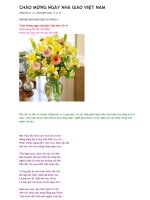báo tường chào mừng ngày 20-11
Bạn đang xem bản rút gọn của tài liệu. Xem và tải ngay bản đầy đủ của tài liệu tại đây (145.83 KB, 7 trang )
<span class='text_page_counter'>(1)</span><div class='page_container' data-page=1>
<b>REIEW: UNIT 1,2,3 – Pronunciation and Grammar</b>
<b>I.</b> <b>The Pronunciation Of The Endings: -S/ES and –ED</b>
<b>1)</b> <b>Cách phát âm các từ tận cùng với “s, es”</b>
– ‘s’ được phát âm là /s/ khi đi sau các âm: p, t, k, f (gh), θ, h.
<b>Ex: maps, cats, books, laughs</b>
– ‘s’ được phát âm là /z/ khi đi sau các âm: b, d, g, v, ,m, n, ng, l, r, j, w, y 5 nguyên âm (a,
e, i, o, u)
<b>Ex: bags, kids, eggs, rooms, pens, rings, hills, hairs, cows, days, lives, patatoes</b>
– ‘es’ được phát âm là /iz/ khi đi sau các âm: s, sh, ch, z, x, ge
<b>Ex: kisses, washes, watches, buzzes, mixes, oranges, pages</b>
<b>2)</b> <b>Cách phát âm các từ tận cùng với “ed”.</b>
- ‘ed’ được phát âm là /Id/ khi đi sau các âm: t, d
<b>Ex: wanted, started, needed, mended</b>
- ‘ed’ được phát âm là /t/ khi đi sau các âm: p, k, f (gh), s, sh, ch, h, x
<b>Ex: stopped, booked, laughed, missed, washed, watched, faxed, </b>
- ‘ed’ được phát âm là /d/ khi đi sau các âm: b, g, v, ,m, n, ng, l, r, j, w, y 5 nguyên âm (a, e,
i, o, u)
<b>Ex: robbed, planned, called, oferred, borrowed, played, arrived, bathed </b>
<b>3)</b> <b>Qui tắc đánh dấu nhấn ở những từ 2 âm tiết.</b>
a). Qui tắc cho DANH TỪ:
+ Nếu âm tiết thứ 2 có nguyên âm ngắn thì nhấn vào âm tiết đầu:
Ví dụ: Money, PROduct, LARlynx (âm tiết thứ 2 mang âm ngắn)
+ Nếu khơng thì nhấn vào âm tiết thứ 2:
Ví dụ: balLOON, deSIGN, esTATE (âm tiết thứ 2 mang âm dài).
b). Qui tắc cho ĐỘNG TỪ và TÍNH TỪ :
+) Nếu âm tiết thứ 2 có ngun âm dài hay ngun âm đơi hoặc nó tận cùng bằng hơn
một phụ âm thì nhấn vào âm tiết thứ 2:
Ví dụ: apPLY, arRIVE - nguyên âm đôi
atTRACT, asSIST- kết thúc nhiều hơn một phụ âm.
+ Nếu âm tiết cuối có nguyên âm ngắn và có một hoặc khơng có phụ âm cuối thì chúng ta
nhấn vào âm tiết thứ 1.
Ví dụ:
Enter, Envy, Open, Equal - khơng có phụ âm cuối và ngun âm cuối là nguyên âm ngắn
<b>Lưu ý:</b> rất nhiều động từ và tính từ có hai âm tiết khơng theo qui tắc (tiếng anh mà, có rất nhiều
qui tắc nhưng phần bất qui tắc lại ln nhiêù hơn). ví dụ như HOnest, PERfect
<b>II.</b> <b>TENSES:</b>
<b>1)</b> <b>Present simple : ( hiện tại đơn)</b>
<i>a.</i> <i>Form ( hình thức)</i>
Khẳng định: I / you / we / they + V1 ……
He / she / it + verb (s / es)……
Phủ định : I / you / we / they + don’t + infinitive….
He / she / it + doesn’t + infinitive……
Nghi vấn : Do + I / you / we / they + infinitive…..?
</div>
<span class='text_page_counter'>(2)</span><div class='page_container' data-page=2>
<i>b.</i> <i>Use ( cách dùng):</i>
- Diễn tả hành động xảy ra thường xuyên hoặc một thói quen ở hiện tại
Ex: Do you often go to the cinema ?
We sometimes go sailing at weekends.
He smokes twenty cigarettes a day.
We go to the country every weekend.
Cách nhận biết:
<i><b>always (luôn luôn), </b></i>
<i><b>often (thường), </b></i>
<i><b>usually / generally (thường thường), </b></i>
<i><b>sometimes (thỉnh thoảng), </b></i>
<i><b>every + time (hằng, mỗi ….)</b></i>
<i><b>today </b></i>
<i><b>once / twice …+ a + time (một / hai … lần)</b></i>
<b>2)</b> <b> Present continuous ( Hiện tại tiếp diễn )</b>
<i>a.</i> <i>Form ( hình thức)</i>
Khẳng định: S + am / are / is + V-ing …….
Phủ định : S + am / are / is + not + V-ing ……
Nghi vấn : Am / Are / Is + S + V-ing ……?
<i>b.</i> <i>Use ( cách dùng)</i>
- Diễn tả một hàng động đang xảy ra vào lúc nói
Ex: What’s that smell ? Something is burning in the kitchen .
Why are you wearing that funny hat ?
I work in a bakery everyday . But I’m working in a shop this week .
Cách nhận biết: now , right now / at the moment /at once/ at present.
<b>3)</b> <b>Present perfect ( Hiện tại hoàn thành )</b>
<i>a.</i> <i> Form ( Hình thức )</i>
Khẳng định : I/ you /we /they + have + V3 / V-ed …
He /she /it + has + V3 / V-ed……
Phủ định : I/ you /we /they + have + not + V3 / V-ed …
He /she /it + has + not + V3 / V-ed……
Nghi vấn : Have + you they + V3 / V-ed …. ?
Has + he /she /it + V3 / V-ed……?
<i>b.</i> Use (Cách dùng )
- Dùng để chỉ hành động xảy ra trong quá khứ và kéo dài đến hiện tại
Ex: I have learnt English for<i> 4 years .</i>
My mother has decorated the house since yesterday.
He has seen that actor many times.
Cách nhận biết:
<i><b>for (suốt)</b></i>
<i><b>since (kể từ) </b></i>
<i><b>up to now / so far / until now / up to present (cho tới nay ) </b></i>
<i><b>for ages ( đã lâu) </b></i>
<i><b>just (vừa mới)</b></i>
<b>already (rồi)</b>
</div>
<span class='text_page_counter'>(3)</span><div class='page_container' data-page=3>
<i><b>ever (đã từng)</b></i>
<i><b>still (vẫn còn)</b></i>
<i><b>not…yet (chưa)</b></i>
<i><b>once= one time(1 lần), twice= two times (2 lần), three times (3 lần), … n times (… lần)</b></i>
<i><b>several times = many times (nhiều lần)</b></i>
<i><b>recently / lately (gần đây)</b></i>
<i><b>NOTES: </b></i> <sub></sub> FOR + khoảng thời gian Ex: for 3 hours, for a long time
<sub></sub> SINCE + mốc thời gian Ex: since 1968, since last Christmas
<b>4)</b> <b> Simple past ( Quá khứ đơn ) </b>
<i>a.</i> <i>Form ( hình thức)</i>
Khẳng định: S + V2 / V-ed ……
Phủ định : S + didn’t + infinitive ….
Nghi vấn : Did + S + infinitive …..?
<i>b.</i> <i> Use ( cách dùng )</i>
- Diễn tả hành động xảy ra và chấm dứt tại một thời điểm hoặc khoảng thời gian xác định
trong quá khứ
Ex: He met her yesterday.
He lived in Hanoi from 1990 to 2000.
They didn’t meet each other last night.
Cách nhận biết: yesterday, ago, last + time , in + year (past) , from… to…(past)
<b>5)</b> <b> Past continuous ( Quá khứ tiếp diễn ) </b>
<i>a.</i> <i>Form ( hình thức)</i>
Khẳng định: I / we / you / they + were + V-ing …….
She / He / It + was + V-ing …….
Phủ định : I / we / you / they + were + not + V-ing ……
She / He / It + was + not + V-ing …….
Nghi vấn : Were + I / we / you / they + V-ing ……?
Was + she / he / it + V-ing ……?
<i>b.</i> <i>Use ( cách dùng )</i>
- Diễn tả hành động đang xảy ra tại một thời điểm xác địng trong quá khứ
Ex: What were you doing at 8.00 last night ? I was watching television .
- Diễn tả một hành động bị gián đoạn
Ex: While I was having a bath, the phone rang .
He was making some coffee when we arrived .
- Diễn tả hai hành động diễn ra cùng một lúc
Ex: I was learning my lesson while my parents were watching TV at 8.30 last night
While he was playing football, we were listening to music.
</div>
<span class='text_page_counter'>(4)</span><div class='page_container' data-page=4>
<b>At that moment ( vào lúc nói)</b>
<b>At that time (vào lúc nói)</b>
<b>At this time yesterday / last … (vào lúc này hôm qua)</b>
<b>At this time last night ( vào lúc này tối hôm qua)</b>
<b>At 4 (5, 6 …) o'clock yesterday (vào lúc 4 (5, 6…) giờ hôm qua.)</b>
<b>All day yesterday (suốt ngày hôm qua)</b>
<b>6)</b> <b>Past perfect (Q khứ hồn thành) </b>
<i>a.</i> <i>Form ( Hình thức )</i>
Khẳng định : S + had + V3 / V-ed …
Phủ định : S + had + not + V3 / V-ed …
Nghi vấn : Had + S + V3 / V-ed …. ?
<i>b.</i> <i>Use (Cách dùng )</i>
- Diễn tả hành động xảy ra trước một hành động khác hoặc thời điểm khác trong quá khứ
Ex: After my parents had already eaten, I got home.
Until yesterday , I had never heard about it .
He had washed his clothes before he learnt his lesson.
Cách nhận biết: before, after.
<b>7.</b> <b>Simple future ( Tương lai đơn )</b>
a.Form ( Hình thức )
Khẳng định :S + will / shall + infinitive …
Phủ định : S + will / shall + not + infinitive …
Nghi vấn : Will / Shall + S + infinitive …. ?
<i>b.Use (Cách dùng )</i>
- Diẽn tả hành động sẽ xảy ra tại một thời điểm nào đó trong tương lai
Ex: He will finish his work tomorrow.
We shall have our examination next month.
- Diễn đạt một nghi nghờ, một yêu cầu , hay sự mời mọc ( thường ở dạng câu hỏi ).
Ex: Will you go shopping with me now ?
Cách nhận biết: tomorrow , next + time, soon, someday, this evening, tonight, this
<i><b>afternoon</b></i>
<b> 8. Near Future ( Tương lai gần ) </b>
a.Form (Hình thức )
Khẳng định : S + is / are / am going to + infinitive …
Phủ định : S + is / are / am not going to + infinitive …
Nghi vấn : Is / Are + S + going to + infinitive …?
<i>b.Use (Cách dùng )</i>
- Một hành động hoặc một sự kiện được lên kế hoạch cho tương lai
Ex: My sister is going to get married
- Một hành động hoặc một sự kiện chắc chắn sẽ xảy ra trong tương lai (có thể nhình thấy
một số dấu hiệu
Ex: Look at the black clouds. It is going to rain.
<b>III.</b> <b>REPORTED SPEECH (Câu tường thuật)</b>
</div>
<span class='text_page_counter'>(5)</span><div class='page_container' data-page=5>
- Ngôi cần phải thay đổi cho phù hợp
- Các thì và trạng từ
<b>1.</b> <b>Personal (ngơi):</b>
- Ngôi thứ nhất (I, we) đổi theo chủ từ của mệnh đề chính.
Ex: He said: “I am hungry” → He said he was hungry
- Ngôi thứ ba (she, he, it, they, Noun) : giữ nguyên
Ex: He said: “He is hungry” → He said he was hungry
- Ngơi thứ hai (you):
+ Mệnh đề chính khơng có túc từ: ngơi “you” giữ ngun
Ex: He said: “you are hungry” → He said you were hungry
+ Mệnh đề chính có túc từ: ngơi “you” đổi theo túc từ của mệnh đề chính.
Ex: He said to me: “you are hungry” → He told I was hungry
<b>2.</b> <b>Quy tắc đổi thì và trạng từ</b>
<b>Thì và </b>
<b>trạng </b>
<b>từ </b>
<b>Direct speech</b> <b>Reported speech</b>
1. Thì
a. Simple present : S + V (s / es)
b. Present continuous: S + am/is/are + V-ing
c. Present perfect: S + have / has + p.p
d. Past simple : S + V2 / V-ed
e. Past continuous:
S + was / were + V-ing
f. Past Perfect: S + had + p.p
g. Must / have to + infinitive
h. Can / May / Will / Shall + infinitive
a. Past simple : S + V2 / V-ed
b. Past continuous: S + was/were + V-ing
c. Past perfect : S + had + p.p
d. Past perfect: S + had + p.p
e. Past perfect continuous:
S + had been + V-ing
f. Past Perfect: S + had + p.p
g. Had to + infinitive
h. Could / Might / Would / Should + inf
2.
Trạng
từ
a. Now
b. Today
c. Tonight
d. Tomorrow
e. Yesterday
f. Last night
g. Ago
h. Here
i. This
j. These
a. Then
b. That day
c. That night
d. The next day / the following day
e. The previous day / the day before
f. The night before
g. Before
h. There
i. That
j. Those
<b>A.</b> <b>STATEMENTS (Câu phát biểu)</b>
Ex 1: They say: “She is going to America for six months”
<sub></sub> They say (that) she is going to America for six months
</div>
<span class='text_page_counter'>(6)</span><div class='page_container' data-page=6>
<sub></sub> She told me she had gone home early
<b> Note: Nếu động từ tường thuật ở thì hiện tại đơn/hiện tại hoàn thành/hiện tại tiếp</b>
diễn/tương lai (say/have said/is/are saying/will say)<sub></sub> động từ trong mệnh đề tường thuật
khơng có sự thay đổi về thì.
Nếu động từ tường thuật ở quá khứ đơn/quá khứ hồn thành/q khứ tiếp diễn
(said / told) <sub></sub> thì động từ trong mệnh đề tường thuật phải lùi một thì.
<b>B.</b> <b>INTERROGATIVE (Câu hỏi ) </b>
<b>1.</b> <b>YES / NO questions </b>
Ex: She said, “Are you thirsty, Peter?”
<sub></sub> She asked Peter if (whether) he was thirsty.
He asked me, “Did you go to school yesterday?”
<sub></sub> He asked me if (whether) I had gone to school the day before.
<b>2.</b> <b>WH – questions</b>
Ex: He asked, “What have you got in your bag?”
<sub></sub> He asked (me) what I had got in my bag
He said, “Mary, when is the next train?”
<sub></sub> He asked Mary when the next train was
<b>Notes: Đổi câu hỏi sang câu phát biểu trước khi đổi sang câu tường thuật</b>
<b>C.</b> <b>IMPERATIVE (Câu mệnh lệnh)</b>
<b>1.</b> <b>Affirmative (khẳng định)</b>
Ex : “Stay in bed for a few days”. The doctor said to me.
<sub></sub> The doctor told me to stay in bed for a few days.
<b>2.</b> <b>Negative (Phủ định)</b>
Ex : “Don’t wait”, he said to me
<sub></sub> He asked me not to wait
“Never do that again”, she said to her son
<sub></sub> She told her son never to do that again.
<b>IV.</b> <b>STRUCTURE:</b>
- S + tobe + adj + to-infinitive – Ex: It is difficult to learn English.
- There / Here + tobe +Noun (‘tobe’ số ít hay nhiều phụ thuộc vào danh từ) + to-infinitive.
Ex: There are many ways to tell something.
- most + countable noun (plural) + Vplural - Ex: most pupils are hard
- most + uncountable noun (singular) + Vsingular - Ex: most water is polluted
- most of the (his, her, their, our, your, my, its, …) + Noun + Verb
Ex: most of the pupils are hard / most of my pupils are hard
most of the water is polluted.
</div>
<span class='text_page_counter'>(7)</span><div class='page_container' data-page=7></div>
<!--links-->









